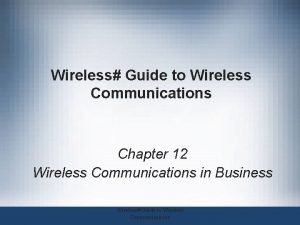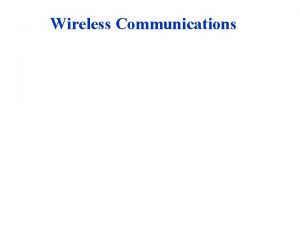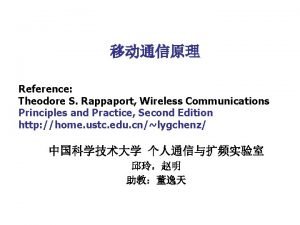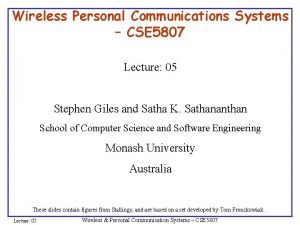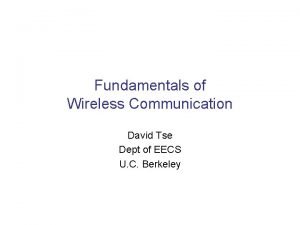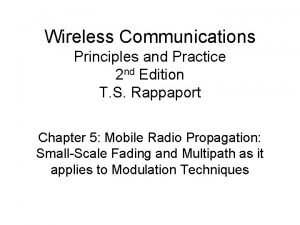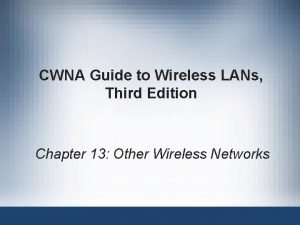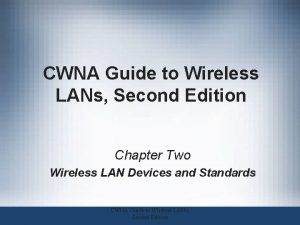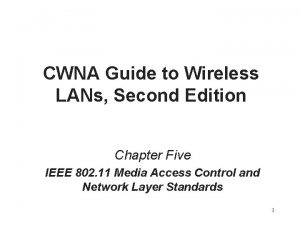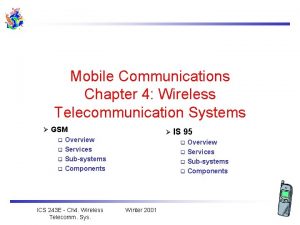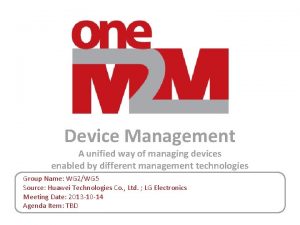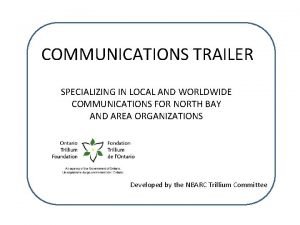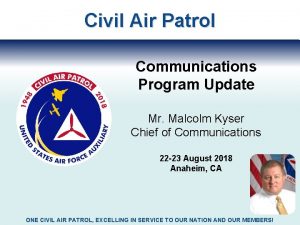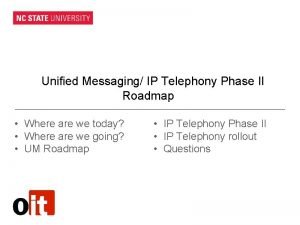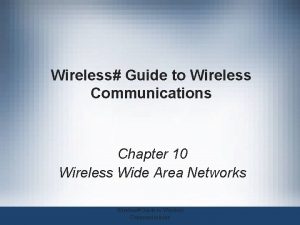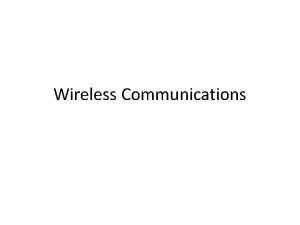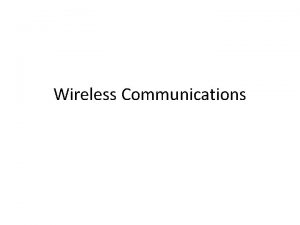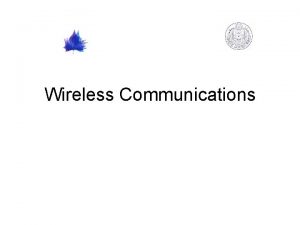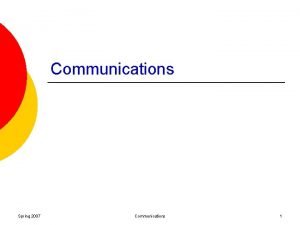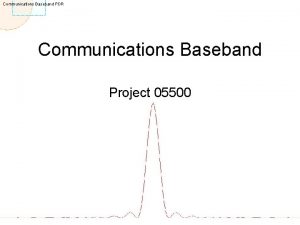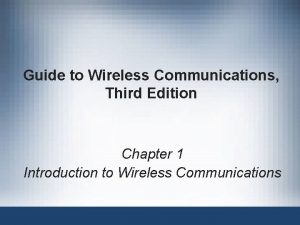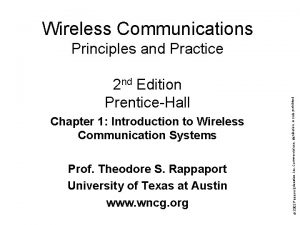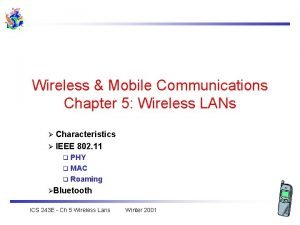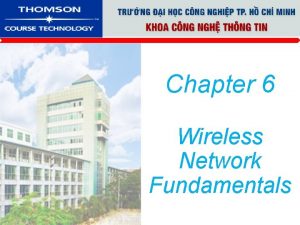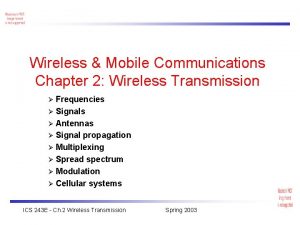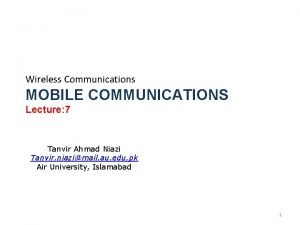Wireless Guide to Wireless Communications Chapter 9 Wireless






























































- Slides: 62

Wireless# Guide to Wireless Communications Chapter 9 Wireless Metropolitan Area Networks Wireless# Guide to Wireless Communications

Objectives • Explain why wireless metropolitan area networks (WMANs) are needed • Describe the components and modes of operation of a WMAN • List the range of WMAN technologies, including FSO, LMDS, MMDS, and 802. 16 (Wi. MAX) • Explain how WMANs function • Outline the security features of WMANs Wireless# Guide to Wireless Communications 2

What is a WMAN? • Wireless metropolitan area networks (WMANs) – Provide wireless connectivity across a substantial geographical area such as a large city • WMANs primary goals – Extend wired networks beyond a single location • Without the expense of high-speed cable-based connections – Extend user mobility throughout a metropolitan area – Provide high-speed connections to areas not serviced by any other method of connectivity Wireless# Guide to Wireless Communications 3

Last Mile Wired Connections • Last mile connection – Link between a customer and ISP – Most last mile connections use copper wiring • Copper-based digital communications lines – Require the signal to be regenerated every 6, 000 feet • Last mile delivery of telephone and data lines has long been a problem for the carrier – Must be able to justify the cost of installing wired connections to remote areas Wireless# Guide to Wireless Communications 4

Last Mile Wired Connections (continued) Wireless# Guide to Wireless Communications 5

Last Mile Wired Connections (continued) Wireless# Guide to Wireless Communications 6

Last Mile Wireless Connections • Microwaves are higher frequency RF waves – In the 3 to 30 GHz range of the electromagnetic spectrum known as super high frequency (SHF) band • Microwave towers are installed roughly 35 miles (56 kilometers) apart from each other • Fixed wireless – Wireless as the last mile connection for buildings • Backhaul connection – Company’s internal infrastructure connection Wireless# Guide to Wireless Communications 7

Baseband vs. Broadband • Broadband transmission – Sends multiple signals at different frequencies • Baseband transmission – Treats the entire transmission medium as if it were only one channel – Only one signal can be set at a time Wireless# Guide to Wireless Communications 8

Baseband vs. Broadband (continued) Wireless# Guide to Wireless Communications 9

Land-Based Fixed Broadband Wireless • Most are proprietary solutions or RF-based equipment – Require licensed frequency bands • Solutions – Free Space Optics – Local multipoint distribution service – Multichannel multipoint distribution service Wireless# Guide to Wireless Communications 10

Free Space Optics • Free space optics (FSO) – Optical, wireless, point-to-point, line-of-sight broadband technology – Excellent alternative to high-speed fiber-optic cable – Can transmit up to 1. 25 Gbps at a distance of 4 miles (6. 4 kilometers) in full-duplex mode – Uses infrared (IR) transmission instead of RF • Transmissions are sent by low-powered invisible infrared beams through the open air – FSO is a line-of-sight technology Wireless# Guide to Wireless Communications 11

Free Space Optics (continued) Wireless# Guide to Wireless Communications 12

Free Space Optics (continued) • Advantages of FSO – – Cost Speed of installation Transmission rate Security • Disadvantages of FSO – Atmospheric conditions impact FSO transmissions – Scintillation • Temporal and spatial variations in light intensity caused by atmospheric turbulence Wireless# Guide to Wireless Communications 13

Free Space Optics (continued) • Disadvantages of FSO (continued) – FSO overcomes scintillation by sending the data in parallel streams (spatial diversity) • From several separate laser transmitters – Dealing with fog • Increase the transmit power of the signal – Signal interference – Tall buildings or towers can sway due to wind or seismic activity • Affecting the aim of the beam Wireless# Guide to Wireless Communications 14

Free Space Optics (continued) Wireless# Guide to Wireless Communications 15

Free Space Optics (continued) • FSO applications – – Last mile connection LAN connections Fiber-optic backup Backhaul Wireless# Guide to Wireless Communications 16

Local Multipoint Distribution Service (LMDS) • Local multipoint distribution service (LMDS) – Fixed broadband technology that can provide a wide variety of wireless services • • • High-speed Internet access Real-time multimedia file transfer Remote access to local area networks Interactive video, video-on-demand, video conferencing Telephone service – Can transmit from 51 to 155 Mbps downstream and 1. 54 Mbps upstream • Over a distance of up to about 5 miles (8 kilometers) Wireless# Guide to Wireless Communications 17

Local Multipoint Distribution Service (LMDS) (continued) Wireless# Guide to Wireless Communications 18

Local Multipoint Distribution Service (LMDS) (continued) • Frequency – Based on high frequency, low-powered signals over short distances – LMDS used the following ranges of frequencies • 27. 5 MHz and 28. 35 MHz • 29. 1 MHz and 29. 25 MHz • 30 GHz, 31. 075 GHz, and 31. 225 GHz • Architecture – Cells (like a cellular telephone system) – LMDS is a fixed wireless technology for buildings Wireless# Guide to Wireless Communications 19

Local Multipoint Distribution Service (LMDS) (continued) • Architecture (continued) – Factors that determine the cell size • • Line-of-sight Antenna height Overlapping cells Rainfall Wireless# Guide to Wireless Communications 20

Local Multipoint Distribution Service (LMDS) (continued) Wireless# Guide to Wireless Communications 21

Local Multipoint Distribution Service (LMDS) (continued) Wireless# Guide to Wireless Communications 22

Local Multipoint Distribution Service (LMDS) (continued) Wireless# Guide to Wireless Communications 23

Local Multipoint Distribution Service (LMDS) (continued) • Architecture (continued) – LMDS signals are broadcast from radio hubs that are deployed throughout the carrier’s market • Area in which the LMDS provider has a license to use a certain frequency – Hub connects to the service provider’s central office • Can connect to other networks, such as the Internet – Equipment at the receiving site • 12 - to 15 -inch diameter directional antenna • Digital radio modem • Network interface unit Wireless# Guide to Wireless Communications 24

Local Multipoint Distribution Service (LMDS) (continued) Wireless# Guide to Wireless Communications 25

Local Multipoint Distribution Service (LMDS) (continued) Wireless# Guide to Wireless Communications 26

Local Multipoint Distribution Service (LMDS) (continued) • Architecture (continued) – LMDS systems can use either: • Time division multiple access (TDMA) • Frequency division multiple access (FDMA) – Modulation techniques • Quadrature phase shift keying (QPSK) • Quadrature amplitude modulation (QAM) • Advantages of LMDS – Cost, service area, and data capacity Wireless# Guide to Wireless Communications 27

Local Multipoint Distribution Service (LMDS) (continued) • Disadvantages of LMDS – LMDS requires a direct line of sight between buildings – LMDS signals are susceptible to interference from rain and fog Wireless# Guide to Wireless Communications 28

Multichannel Multipoint Distribution Service (MMDS) • Multichannel multipoint distribution service (MMDS) – Fixed broadband wireless technology similar to LMDS – Can transmit video, voice, or data signals at 1. 5 to 2 Mbps downstream and 320 Kbps upstream • At distances of up to 35 miles (56 kilometers) – MMDS is sometimes called wireless cable • Can broadcast 300 channels – Internet access using MMDS is an alternative to cable modems and DSL service Wireless# Guide to Wireless Communications 29

Multichannel Multipoint Distribution Service (MMDS) (continued) • Layout – MMDS hub is typically located on a high point • Uses a point-to-multipoint architecture that multiplexes communications to multiple users – Tower has a backhaul connection to carrier’s network • Carrier network connects with the Internet – MMDS signals can travel longer distances • Provide service to an entire area with only a few radio transmitters – MMDS cell size can have a radius of up to 35 miles (56 kilometers) Wireless# Guide to Wireless Communications 30

Multichannel Multipoint Distribution Service (MMDS) (continued) • Layout (continued) – Pizza box antenna • 13 by 13 inches antenna used at receiving site • Aimed at the hub to receive the MMDS signal – Cable runs from the antenna to an MMDS wireless modem • Modem can connect to a single computer or an LAN Wireless# Guide to Wireless Communications 31

Multichannel Multipoint Distribution Service (MMDS) (continued) Wireless# Guide to Wireless Communications 32

Multichannel Multipoint Distribution Service (MMDS) (continued) Wireless# Guide to Wireless Communications 33

Multichannel Multipoint Distribution Service (MMDS) (continued) • Advantages of MMDS – Signal strength – Cell size – Cost • Disadvantages of MMDS – – Physical limitations Frequency sharing Security Availability of the technology Wireless# Guide to Wireless Communications 34

IEEE 802. 16 (Wi. MAX) • Standard for wireless broadband metropolitan area networks • 802. 16 supports enhancements and extensions to the MAC protocols – Base station (BS) can communicate with another BS • And also directly with subscriber stations (SS) • Wi. MAX Forum – Promotes the implementation of 802. 16 by testing and certifying equipment • Wi. MAX stands for worldwide interoperability for microwave access Wireless# Guide to Wireless Communications 35

Wi. MAX Applications • Applications – Suitable for backhaul applications for business – Last mile delivery applications – Supports simultaneous voice, video, and data transmission – Suitable for voice-over-IP (Vo. IP) connections – Enables vendors to create customer premises equipment (CPE) – Can also be deployed as a point-to-point network • Provide broadband access to rural and remote areas Wireless# Guide to Wireless Communications 36

Wi. MAX Applications (continued) • Applications (continued) – Wi. MAX CPE devices will support TV (video), telephone (voice), and data on the same network • Wi. MAX MAC layer makes it easy for carriers to deploy the network • Range of a Wi. MAX network is measured in miles • Cellular phone operators can easily incorporate Wi. MAX networks Wireless# Guide to Wireless Communications 37

Standards Family Overview • 802. 16 -2001 and 802. 16 -2004 standards – Define the interface specification for fixed, point-tomultipoint broadband WMANs • 802. 16 a – Supports systems in the 2 GHz to 11 GHz band • 802. 16 c – Provided clarifications related to performance evaluation and testing • 802. 16 e – Defines specifications for a mobile version of Wi. MAX Wireless# Guide to Wireless Communications 38

Wi. MAX Protocol Stack • PHY layer supports multiple frequency bands and several modulation techniques • Wi. MAX MAC layer is connection oriented – Includes service-specific convergence sublayers • That interface to the upper OSI layers • Wi. MAX offers multiple simultaneous services through the same link – Asynchronous transfer mode (ATM), IPv 4, IPv 6, Ethernet, and VLAN Wireless# Guide to Wireless Communications 39

Wi. MAX Protocol Stack (continued) Wireless# Guide to Wireless Communications 40

Wi. MAX Protocol Stack (continued) • PHY layer – Five variations of the PHY layer in 802. 16 – First two are based on the modulation of a single carrier signal • Transmission is half-duplex • Each frame is subdivided into one uplink subframe and one downlink subframe • Subframes are further divided into a series of time slots • Burst is a data transmission to or from a single device • Use time division duplexing (TDD) Wireless# Guide to Wireless Communications 41

Wi. MAX Protocol Stack (continued) Wireless# Guide to Wireless Communications 42

Wi. MAX Protocol Stack (continued) • PHY layer (continued) – Wi. MAX allows two different frequency channels • Frequency division duplexing (FDD) – Wi. MAX can support half-duplex and full-duplex equipment – Variations of the PHY layer specified in the standard • Wireless. MAN-SC (single carrier) • Wireless. MAN-SCa (single-carrier access) – 802. 16 standard also provides support for non-line-ofsight applications Wireless# Guide to Wireless Communications 43

Wi. MAX Protocol Stack (continued) Wireless# Guide to Wireless Communications 44

Wi. MAX Protocol Stack (continued) • PHY layer (continued) – Additional PHY layer transmission mechanisms to support NLOS applications • Wireless. MAN-OFDM – Uses TDMA • Wireless. MAN-OFDMA – Divides the available channel into a large number of orthogonal subcarriers – Third transmission mechanism • Wireless high-speed unlicensed metro area network (Wireless. HUMAN) Wireless# Guide to Wireless Communications 45

Wi. MAX Protocol Stack (continued) Wireless# Guide to Wireless Communications 46

Wi. MAX Protocol Stack (continued) • Modulation and error correction – – 802. 16 uses forward error correction 802. 16 also uses automatic repeat requests (ARQ) 802. 16 dynamically changes modulations Latency • Amount of time delay that it takes a packet to travel from source to destination device – 802. 16 defines several transmission profiles • Sets of predefined connection parameters – System profiles are combination of the basic profile and one of the transmission profiles Wireless# Guide to Wireless Communications 47

Wi. MAX Protocol Stack (continued) Wireless# Guide to Wireless Communications 48

Wi. MAX Protocol Stack (continued) Wireless# Guide to Wireless Communications 49

Wi. MAX Protocol Stack (continued) • Range and throughput – Maximum distances achievable in a Wi. MAX network • Depend on the frequency band used – Higher frequencies are used for • Metropolitan area line-of-sight, point-to-point, or multipoint application at very high data rates – Lower licensed frequencies will be used for • Private, line-of-sight network connections up to 10 miles (16 kilometers) • Long distance links of up to 35 miles Wireless# Guide to Wireless Communications 50

Wi. MAX Protocol Stack (continued) • Range and throughput (continued) – Frequencies below 11 GHz will be used for • Non-line-of-sight networks with a maximum range of up to 5 miles (8 kilometers) Wireless# Guide to Wireless Communications 51

Wi. MAX Protocol Stack (continued) Wireless# Guide to Wireless Communications 52

Wi. MAX Protocol Stack (continued) • MAC layer – Most wireless MAN implementations function in a point-to-multipoint basis • With one BS and potentially hundreds of SSs – 802. 16 MAC dynamically allocates bandwidth to individual SSs for the uplink – Advanced antenna system (AAS) • Transmits multiple simultaneous signals in different directions to stations that fall within the range – Wi. MAX can also take advantage of multiple in multiple out (MIMO) antenna systems Wireless# Guide to Wireless Communications 53

Wi. MAX Protocol Stack (continued) • MAC layer (continued) – BS uses a 16 -bit connection identifier (CID) • To address a burst to a particular SS – Stations can request additional dedicated bandwidth (for Qo. S) – Jitter • Maximum delay variation between two consecutive packets over a period of time – Wi. MAX MAC protocol maintains a consistent bandwidth by using a self-correcting mechanism • For granting more bandwidth to SSs Wireless# Guide to Wireless Communications 54

Wi. MAX Protocol Stack (continued) Wireless# Guide to Wireless Communications 55

Wi. MAX Coexistence • As the number of transmitters grows, so does interference • Wi. MAX is not limited to the 2. 4 GHz or the 5 GHz bands • U-NII band offers 12 channels and about 300 MHz of bandwidth – Wi. MAX signals are limited to between 30 and 35 miles – Interference may not be a serious problem • Adaptive modulations, variable data rates, signal power levels, and FEC help with interference Wireless# Guide to Wireless Communications 56

WMAN Security • Security in WMANs is a major concern • FSO systems are generally considered secure – To sniff information from FSO systems is difficult • Attacker must access the equipment and block only a portion of an invisible beam • LMDS and MMDS systems – RF signals can be captured by a receiver without blocking the radio signal Wireless# Guide to Wireless Communications 57

Wi. MAX Security • MAC layer includes a privacy sublayer – Wi. MAX standard was initially designed to include very powerful security measures • Privacy sublayer provides a client/server authentication and key management protocol – Uses digital certificates • Components in the privacy sublayer – An encapsulation protocol for encrypting packet data – A privacy key management protocol that provides secure key distribution Wireless# Guide to Wireless Communications 58

Wi. MAX Security (continued) • Traffic encryption key (TEK) – Security key used to encrypt the data – SS must renew the keys periodically with the BS – Default TEK lifetime is 12 hours • Data encryption algorithms – 3 -DES – RSA with 1024 -bit key – AES with 128 -bit key Wireless# Guide to Wireless Communications 59

Summary • WMANs are a group of technologies – Provide wireless connectivity throughout an area such as a city without cable infrastructure • Last mile wired connections are the link between the customer’s premises and an ISP • Transmission techniques – Broadband baseband • Land-based fixed broadband wireless techniques – Free space optics (FSO) – Local multipoint distribution service (LMDS) – Multichannel multipoint distribution service (MMDS) Wireless# Guide to Wireless Communications 60

Summary (continued) • IEEE 802. 16 (Wi. MAX) standard introduced in 2000 – Can transmit at speeds up to 70 Mbps in the 2 to 11 GHz bands – Can also achieve 120 Mbps at short distances in the 10 to 66 GHz bands – Bring full support of mobile devices to Wi. MAX technology • The Wi. MAX MAC layer is connection oriented • The BS can support both half-duplex and full-duplex devices simultaneously Wireless# Guide to Wireless Communications 61

Summary (continued) • Variations of the Wi. MAX PHY layers for point-topoint connections: – Wireless. MAN-SC – Wireless. MAN-OFDM • OFDM and OFDMA in 802. 16 are scalable • Wi. MAX transmission profile – Specifies the frequency channel, bandwidth, and transmission mechanism • MAC layer is the key to the intelligence and security behind Wi. MAX Wireless# Guide to Wireless Communications 62
 Guide to wireless communications
Guide to wireless communications Guide to wireless communications
Guide to wireless communications Andrea goldsmith wireless communications
Andrea goldsmith wireless communications Subsea wireless communications
Subsea wireless communications Theodore s rappaport wireless communications
Theodore s rappaport wireless communications Cse
Cse Fundamentals of wireless communications
Fundamentals of wireless communications Sircim
Sircim Telecommunications the internet and wireless technology
Telecommunications the internet and wireless technology Cwna guide to wireless lans 3rd edition
Cwna guide to wireless lans 3rd edition Cwna guide to wireless lans
Cwna guide to wireless lans Cwna guide to wireless lans
Cwna guide to wireless lans A fire department communication center functions
A fire department communication center functions Chapter 4 communications and documentation
Chapter 4 communications and documentation Communications chapter
Communications chapter Chapter 3 network protocols and communications
Chapter 3 network protocols and communications Crisis communications working group
Crisis communications working group Times fiber communications
Times fiber communications Track and report nims
Track and report nims Telecommunications and data communications
Telecommunications and data communications 113-com-1022 powerpoint
113-com-1022 powerpoint 113-com-1022 perform voice communications
113-com-1022 perform voice communications Communication mix
Communication mix Oracle communications services gatekeeper
Oracle communications services gatekeeper Open source unified communications
Open source unified communications Open platform communications unified architecture
Open platform communications unified architecture Who are puma unified communications
Who are puma unified communications Ministry of transport, communications and works
Ministry of transport, communications and works Communications system toolbox
Communications system toolbox The source or sender of an advertising communication
The source or sender of an advertising communication Communications roadmap
Communications roadmap Push pull profile strategies marketing communications
Push pull profile strategies marketing communications Utility communications market analysis
Utility communications market analysis Internal communications system
Internal communications system Communication mix
Communication mix Btl communications
Btl communications Asterisk open source technology
Asterisk open source technology Alokesh banerjee
Alokesh banerjee Idaho state communications
Idaho state communications Slappey communications
Slappey communications Global marketing and communications
Global marketing and communications Employee relations communications
Employee relations communications Device management unified communications
Device management unified communications Live communication server
Live communication server Data and computer communications 10th edition
Data and computer communications 10th edition Data and computer communication
Data and computer communication Crisis communication lecture
Crisis communication lecture Ksa crisis communications
Ksa crisis communications Communications trailer
Communications trailer Communications merit badge requirements
Communications merit badge requirements Club marketing communications chairperson
Club marketing communications chairperson Malcolm kyser
Malcolm kyser Cisco unified communications manager tutorial
Cisco unified communications manager tutorial Managing digital communications
Managing digital communications Business data communications and networking
Business data communications and networking Business data communications and networking
Business data communications and networking Bsa communications merit badge
Bsa communications merit badge Beeone communications sa
Beeone communications sa Vfr communications
Vfr communications Managing mass communication
Managing mass communication Designing and managing marketing communications
Designing and managing marketing communications Bt business unified communications solutions
Bt business unified communications solutions Unified communications roadmap
Unified communications roadmap

